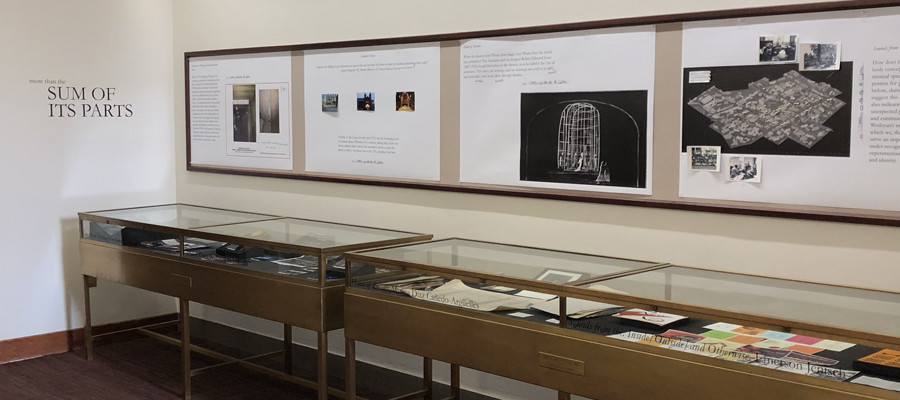
SUM OF ITS PARTS Opens
Thursday, January 25, 2024 at 8:00am
Class of 1928 Vitrines, First Floor, Wesleyan Library, 252 Church Street, Middletown
FREE!
The Center for the Arts (CFA) at Wesleyan University opened in the fall of 1973 as one of many arts centers built on college campuses in an age of robust American government and foundation investment in the arts. In that sense, it is emblematic of a larger social movement that positioned art at the center of social life. As a CFA planning document from 1966 notes, these new buildings were meant to nurture interdisciplinary collaborations and “provide a vital cultural force in the community" that would be “more than the sum of its parts.” In consultation with the Director of the Center for the Arts Joshua Lubin-Levy ’06 and Dietrich Family Associate University Librarian for Unique Collections and University Archivist Amanda Nelson, these four vitrines (glass display cases) feature unique projects developed by student-curators about dance, music, theater, and the visual arts at Wesleyan University. Collectively, they consider the space where art-making occurs on campus, often in tension with the notion of the CFA as the epicenter, thus reflecting a long tradition of campus communities coming together to create within, and against, institutional recognition.
On display through Sunday, April 21, 2024.
House of dreams
Curated by graduate student Marina Díaz Cañedo-Argüelles
Where do dreams rest? Where does magic rest? Where does the sacred rest, nowadays? The dramatist and set designer Robert Edmond Jones (1887–1954) found their place in the theater, or as he called it the “art of awareness.” His plays, his writings, and his drawings are a call to be alive, and more alive, through dream.
Outsider’s Dance
Curated by Nallely (Ellie) Salinas ’24
“...dancers are willing to put themselves in spaces that are not built for them in order to continue practicing their craft.” - Jenny Margolis ‘23, former director of Fusion Dance Crew
Outside of the Center for the Arts lies the booming scene of student dance. Whether it be a church, dining hall, or the outdoors, student dance shows that anywhere can be a space for dance to thrive. Anywhere but in the CFA, anywhere but here.
Sounds from the: Inside/Outside/and Otherwise
Curated by Emerson Jenisch ’25
How does the Wesleyan University student body conceptualize and interact with musical spaces on campus? Programs and posters for performances produced before, during, and after the early 1970s suggest this era was a turning point while also indicating that autonomous and unexpected performance spaces have been and continue to be a key aspect of Wesleyan’s musical culture. The spaces in which we, the students, transmit sound serve an important and often under-recognized role in creative experimentation, expression, togetherness, and identity.
Tunnel Fever: Working in unclaimable dimensions
Curated by Loren Yuehan Wang ’25
Many of the buildings at Wesleyan University are connected by underground tunnels. An article in Hermes published in 1998 describes a broader “tunnel fever” among the campus community, suggesting that these hallowed halls have a peculiar effect on those who would lay claim to them. As institutional power has gradually taken back other student-determined space on campus over the past decades, engagements with tunnels under the Center for the Arts suggest the ongoing way the tunnels provide students with a guerilla relationship to centralized power. From the 1970s to the present, in between the gray concrete walls, the tunnels have shapeshifted into a sanctuary, archive, laboratory, shelter, and more to come.
Read Art Comes to Life through Student Partnership with the Center for the Arts in The Wesleyan Connection.